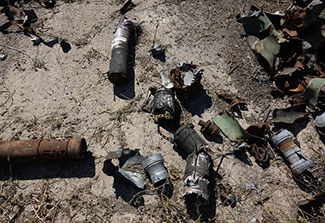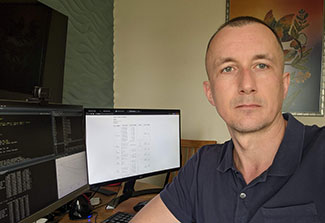Finding a ‘win’ while war is waged in Ukraine
September/October 2023 | Volume 22 Number 5
 Photo courtesy of U.S. Department of State/Chuck KennedyUnexploded ordnance (munitions) in farmland in Yahidne, Ukraine.
Photo courtesy of U.S. Department of State/Chuck KennedyUnexploded ordnance (munitions) in farmland in Yahidne, Ukraine.
By Susan Scutti
The initial shock of a Russian invasion in February 2022 spurred Dr. Kostyantyn Dumchev, scientific director at the Ukrainian Institute of Public Health Policy, to leave Kyiv for his hometown in southwestern Ukraine. “In the first weeks, we were trying to help the country, doing all we could to mobilize aid,” he says. Returning to the capital city within months, he and his colleagues promptly resumed their research.
Dumchev is a primary investigator on two separate Fogarty projects: one a training program with Dr. Jack DeHovitz, distinguished service professor, SUNY Downstate Medical Center; another a research study with Dr. Jill Owczarzak, associate professor, Johns Hopkins University.
"If you try to work and perform your regular duties, that helps your mental health,” says Dumchev.
Despite difficulties, the Ukrainian health care system has shown resilience and is relatively high functioning since the invasion began, says Dumchev. Some facilities directly affected by military action no longer operate, but some partially destroyed clinics have begun renovations, especially in the de-occupied zones. “One challenge is that a lot of people have left,” he says, noting that at peak exodus, 8 to 10 million people crossed the border. Most have returned, but a significant number still live abroad as refugees, he says “There’s a deficit in the health care workforce, especially in the most affected regions.”
The Soviet era as historical context
Some Ukrainian health care system problems can be traced to its roots; it was created during the period Ukraine existed as a republic within the Soviet Union (1922–1991). “The Soviet health care system was very specialized and siloed with limited connections between different services,” says Dumchev. For example, HIV care within Ukraine has operated separately, disconnected from primary care or even other infectious diseases.
Following the 2014 revolution, real change began, says Dumchev. “The role of the primary care doctor has grown, becoming the gateway for all other services, while the clinics try to provide additional services relevant to their main offering—so HIV centers might treat TB, hepatitis or mental health." The trend now is toward integration, a critical strategy as Ukraine continues to experience one of the highest rates of HIV in Europe while people living with HIV (PLWH) suffer multiple co-morbidities.
Before the start of the Russian invasion, only 60% of the estimated 210,000 PLWH were receiving antiretroviral therapy (ART). Among HIV-positive people who inject drugs (PWID), ART rates were even lower; only 54% of PWID were on ART and just 44% were virally suppressed. Notably, at least half of PLWH in Ukraine acquired HIV though IV drug use. “All former Soviet countries and many Eastern European countries have their HIV epidemics driven by injected drug use,” notes Dumchev.
Common influences, common problems
DeHovitz explains that the collapse of the Soviet Union meant economic changes and political dislocation occurring alongside a dramatic increase in opiate trafficking, particularly from Afghanistan. The drug smuggling routes follow the Silk Road through Kazakhstan, Russia, Ukraine and then into the rest of Europe, he says. “It was a perfect storm—the same time that political and economic disruption occurred (with people losing their jobs and having no money), there was also increased availability of cheap drugs. Substance use really took off.” Ukraine also did not deploy some of the interventions that can reduce substance use, he adds, noting that substitution therapy—in the form of methadone and buprenorphine—went against the Soviet medical philosophy. “This inability to implement medication-assisted therapy was a terrible legacy from the Soviet system,” says DeHovitz.
Owczarzak says that stigma has also contributed to high rates of HIV in Ukraine. Her research examining the lives of women living with HIV shows that many patients fear their health care providers will shame them for using drugs.
Support from international donors, including the Global Fund and PEPFAR has helped to limit transmission, leading to a slow decrease in the number of new cases, notes Dumchev. “Still there are gaps in services, not only in prevention but in treatment.”
 Photo courtesy of Kostyantyn DumchevDr. Kostyantyn Dumchev, principal investigator on a Fogarty-funded Ukraine HIV Research Training Program, believes educating researchers in the U.S. is a crucial aspect of the project.
Photo courtesy of Kostyantyn DumchevDr. Kostyantyn Dumchev, principal investigator on a Fogarty-funded Ukraine HIV Research Training Program, believes educating researchers in the U.S. is a crucial aspect of the project.
Using data to make a difference
To optimize HIV care, Dumchev's project with Owczarzak focuses on unused information. Owczarzak explains: “We ask providers to collect a lot of information from their clients, but usually it’s just used for reports or it's like, ‘Okay, you met your metrics; we’ll give you funding again.’” Ukraine’s nationwide medical information system is a rich source of unused data, including HIV care appointments kept, prescriptions for medications, all diagnosed co-morbidities, and clinical and laboratory test results. The project seeks “to empower providers and case managers to use that information for improving the health outcomes of their clients,” says Owczarzak.
Dumchev says, “The goal is to enhance the instruments for data exchange between clinical personnel and case managers to improve HIV treatment outcomes. We also intend to help patients get case management services to prevent them from dropping out of care—or if they’ve dropped out, to quickly get back in.”
One of Owczarzak’s past studies in Ukraine empowered health care providers to develop their own interventions. “A lot of these interventions have similar elements, so, basically, we already know what makes an HIV intervention work,” she says. “We gave providers a sense of what makes a good intervention—we called them the ‘common elements’—and then we worked with them to develop interventions.”
Training methodologies
Dumchev believes training researchers in the U.S. is a “crucial” aspect of his project with DeHovitz. He, himself, entered a Fogarty program after finishing his medical degree at Vinnitsya National Medical University to earn an MPH from University of Alabama at Birmingham. He says, "Our own health care system lacks this public health understanding and attitude. All the people who’ve trained in the U.S. in similar programs have become assets within the Ukrainian health care system.”
The curriculum for DeHovitz and Dumchev’s project includes instruction in substance use interventions. DeHovitz explains: “By ‘substance use’ I’m not only referring to opiates. Alcohol remains a huge problem in the region and now we're starting to see an increase in the use of synthetic drugs. We thought this curriculum would be very helpful, given the burden of substance use in the region.” Students welcome these practical courses, he adds. “Our program in the school of public health is closely linked with the New York State Department of Health, so trainees not only learn theory, but also learn how these interventions are implemented in New York.”
Asked if he can meet his goals in the context of war, DeHovitz says, “I'm assuming the war will be over at some point during the five-year period of this grant… I have to assume that. I believe, once that happens, there will be increased resources for health care and the evolution of the public health system. And we’ll be well-positioned to help.” He’s also been cultivating cross-national research and training with HIV Research Training Programs in Georgia and Kazakhstan. “Ultimately it might enhance collaborations among the various countries.”
Owczarzak says it still humbles and impresses her that her Ukrainian colleagues continue to work, conduct research, and remain committed to providing care. “We don't know when this conflict is going to end—we don't know how it's going to end—but if we can provide another tool to improve HIV care engagement metrics, then that’s a win.”
More information
Updated October 12, 2023
To view Adobe PDF files,
download current, free accessible plug-ins from Adobe's website.
Related Fogarty Programs
Related World Regions / Countries
Related Global Health Research Topics